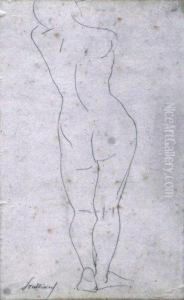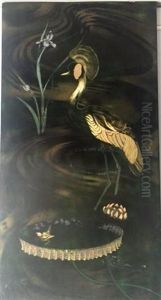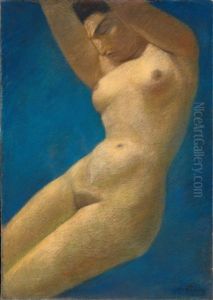Seraphin Soudbinine Paintings
Seraphin Soudbinine was a notable Russian sculptor and ceramist whose career spanned the late 19th and early 20th centuries. Born in 1867, Soudbinine's journey into art was not straightforward. Initially, he embarked on a career in engineering, a path that would inadvertently lead him to his true passion. His transition from engineering to art was influenced by his association with major figures in the Russian art world, including the famous impresario Sergei Diaghilev and the renowned artist Pavel Mikhailovich Tretyakov, the founder of the Tretyakov Gallery in Moscow.
Soudbinine's artistic career truly began to flourish after he moved to Paris, a city that was at the forefront of the avant-garde movement in Europe. It was here that he became deeply involved in the artistic circles that included many Russian émigrés as well as French artists. His work was greatly influenced by his close relationship with the Russian painter, stage designer, and art theorist Pavel Tchelitchew. This association helped Soudbinine to develop a distinctive style that blended traditional Russian artistic elements with the modernist trends prevailing in Paris at the time.
Although Soudbinine is primarily remembered for his sculptures, his contributions to the field of ceramics were significant. He was known for his innovative techniques and the unique aesthetic of his ceramic pieces, which often featured intricate designs and a subtle interplay of colors. His works were exhibited in several major exhibitions, both in Russia and abroad, gaining him international recognition.
Despite his success, Soudbinine remained somewhat on the periphery of the dominant art movements of his time, such as Cubism and Surrealism. Instead, he carved out a niche for himself that bridged the gap between traditional craftsmanship and modernist experimentation. His sculptures, often characterized by their emotive depth and technical precision, reflected his ongoing exploration of the human form and his interest in themes of spirituality and mysticism.
Seraphin Soudbinine passed away in 1944, leaving behind a legacy that, while not as widely recognized as some of his contemporaries, has continued to be appreciated for its unique contribution to the evolution of modern art. His work remains a subject of interest for art historians and collectors, symbolizing a bridge between the rich cultural heritage of Russia and the innovative artistic movements of early 20th-century Europe.



